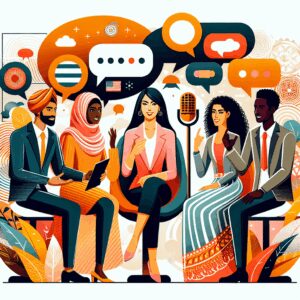Question 1: What is the best way to greet someone from a different culture?
A)
Shake hands firmly.
B)
Use a casual greeting.
C)
Ask about their culture.
✓ Bonne Réponse
D)
Avoid greeting altogether.
Question 2: Which of the following phrases is culturally sensitive?
A)
Why do you dress that way?
B)
Tell me about your traditions.
✓ Bonne Réponse
C)
I don’t understand your customs.
D)
You must be very different.
Question 3: What should you avoid when communicating with someone from a different culture?
A)
Making assumptions.
✓ Bonne Réponse
B)
Listening actively.
C)
Asking questions.
D)
Showing respect.
Question 4: Which expression is appropriate in an intercultural context?
A)
You should be more like us.
B)
I appreciate your perspective.
✓ Bonne Réponse
C)
That's an odd way to think.
D)
Why don't you see it my way?
Question 5: In intercultural communication, what is an important aspect to consider?
A)
Language barriers only.
B)
Nonverbal cues.
✓ Bonne Réponse
C)
Personal opinions.
D)
Local weather conditions.
Question 6: What is the primary focus of intercultural communication?
A)
Understanding cultural differences
✓ Bonne Réponse
B)
Promoting a single culture
C)
Ignoring cultural backgrounds
D)
Focusing only on language barriers
Question 7: In a high-context culture, communication is often characterized by what?
A)
Direct and explicit messages
B)
Relying heavily on context and non-verbal cues
✓ Bonne Réponse
C)
Using simple language
D)
Formal structures
Question 8: Which of the following is a common barrier to effective intercultural communication?
A)
Cultural stereotypes
✓ Bonne Réponse
B)
Shared interests
C)
Common language
D)
Active listening
Question 9: What does the term 'ethnocentrism' refer to?
A)
Understanding and valuing other cultures
B)
Believing one's own culture is superior
✓ Bonne Réponse
C)
Adapting to foreign customs
D)
Neutral perspective on cultures
Question 10: Which of these is an effective strategy for overcoming intercultural misunderstandings?
A)
Assuming intentions based on stereotypes
B)
Practicing active listening and empathy
✓ Bonne Réponse
C)
Avoiding discussions about culture
D)
Sticking to one's own cultural norms
Question 11: What is the impact of cultural norms on communication styles?
A)
They have no effect on communication.
B)
They dictate how messages are interpreted.
✓ Bonne Réponse
C)
They only affect non-verbal communication.
D)
They make communication universally the same.
Question 12: In which culture is silence often seen as a sign of respect or contemplation?
A)
Western cultures
B)
Asian cultures
✓ Bonne Réponse
C)
African cultures
D)
Latin American cultures
Question 13: Which term describes the process of adapting behavior and values when interacting with people from different cultures?
A)
Acculturation
✓ Bonne Réponse
B)
Assimilation
C)
Integration
D)
Segregation
Question 14: What role does body language play in intercultural communication?
A)
It is less important than spoken language.
B)
It can vary significantly between cultures.
✓ Bonne Réponse
C)
It conveys universal meanings.
D)
It is often ignored by communicators.
Question 15: Which of the following is a characteristic of individualistic cultures?
A)
Emphasis on group harmony
B)
Prioritizing personal goals over group goals
✓ Bonne Réponse
C)
Strong family ties
D)
Collective decision-making
Question 16: What is one way to show cultural sensitivity during a conversation?
A)
Using slang from your own culture
B)
Listening actively and asking questions
✓ Bonne Réponse
C)
Dominating the conversation
D)
Avoiding eye contact
Question 17: How can one improve their intercultural communication skills?
A)
By relying solely on language proficiency
B)
By engaging in cultural exchange programs
✓ Bonne Réponse
C)
By avoiding interactions with other cultures
D)
By sticking to familiar topics
Question 18: Which approach is most effective when facing a cultural misunderstanding?
A)
Confronting the other party aggressively
B)
Taking a step back to assess the situation
✓ Bonne Réponse
C)
Ignoring the misunderstanding
D)
Blaming the other culture
Question 19: What can be a positive outcome of effective intercultural communication?
A)
Increased conflict
B)
Stronger relationships between cultures
✓ Bonne Réponse
C)
Greater cultural isolation
D)
Misinterpretation of messages
Question 20: Why is it important to understand cultural context in communication?
A)
It is not essential.
B)
It helps avoid misinterpretations.
✓ Bonne Réponse
C)
It complicates the communication process.
D)
It limits freedom of speech.
Question 21: What is an example of a low-context culture?
A)
Japan
B)
Germany
✓ Bonne Réponse
C)
China
D)
Saudi Arabia
Question 22: What should you do if someone from another culture misinterprets your message?
A)
Get angry and defensive
B)
Clarify your message respectfully
✓ Bonne Réponse
C)
Ignore their reaction
D)
Blame them for misunderstanding
Question 23: How do collectivist cultures typically view conflict?
A)
As a necessary evil
B)
As an opportunity for personal growth
C)
As something to be avoided
✓ Bonne Réponse
D)
As a path to individual success
Question 24: Which factor can enhance intercultural communication?
A)
Cultural arrogance
B)
Open-mindedness
✓ Bonne Réponse
C)
Assumptions about others
D)
Avoiding difficult conversations
Question 25: What does cultural relativism advocate?
A)
Judging other cultures by one's own standards
B)
Understanding cultures on their own terms
✓ Bonne Réponse
C)
Promoting one culture over others
D)
Rejecting all cultural norms
Question 26: Which of the following is a sign of effective non-verbal communication?
A)
Inconsistent facial expressions
B)
Maintaining appropriate eye contact
✓ Bonne Réponse
C)
Ignoring body language
D)
Using closed body posture
Question 27: What is the effect of stereotypes in intercultural communication?
A)
They help in understanding cultures better.
B)
They can lead to misunderstandings and biases.
✓ Bonne Réponse
C)
They are always accurate.
D)
They promote open dialogue.
Question 28: Which communication style is often used in formal settings in many cultures?
A)
Casual and informal
B)
Direct and to the point
C)
Indirect and nuanced
✓ Bonne Réponse
D)
Humorous and relaxed
Question 29: What is an example of an intercultural communication skill?
A)
Ignoring cultural differences
B)
Adapting your communication style
✓ Bonne Réponse
C)
Sticking to your own cultural norms
D)
Using complex jargon
Question 30: Which of the following can be considered a cultural faux pas?
A)
Expressing gratitude
B)
Making direct eye contact
C)
Failing to greet someone appropriately
✓ Bonne Réponse
D)
Using polite language
Question 31: What is the primary goal of intercultural communication?
A)
To understand cultural differences
✓ Bonne Réponse
B)
To promote linguistic diversity
C)
To establish a universal language
D)
To eliminate cultural stereotypes
Question 32: In a high-context culture, communication relies heavily on:
A)
Verbal expressions
B)
Contextual cues
✓ Bonne Réponse
C)
Written documents
D)
Direct confrontation
Question 33: Which of the following is a potential barrier to intercultural communication?
A)
Cultural awareness
B)
Language differences
✓ Bonne Réponse
C)
Shared experiences
D)
Mutual respect
Question 34: When communicating with someone from a collectivist culture, it is important to:
A)
Focus on individual achievements
B)
Emphasize group harmony
✓ Bonne Réponse
C)
Encourage competition
D)
Highlight personal goals
Question 35: What is a common practice in low-context cultures?
A)
Indirect communication
B)
Use of metaphors
C)
Explicit verbal messages
✓ Bonne Réponse
D)
Reliance on non-verbal signals
Question 36: Which of the following is NOT an element of cultural intelligence?
A)
Cognitive
B)
Emotional
C)
Physical
D)
Technical
✓ Bonne Réponse
Question 37: In intercultural situations, what does 'ethnocentrism' refer to?
A)
Understanding and valuing other cultures
B)
Believing one's culture is superior
✓ Bonne Réponse
C)
Adopting practices from other cultures
D)
Promoting cultural exchange
Question 38: What does the term 'cultural relativism' mean?
A)
All cultures are equal in value
B)
Cultures should be judged by their own standards
✓ Bonne Réponse
C)
Cultural practices should be ignored
D)
One culture is better than another
Question 39: When providing feedback in a multicultural setting, it is important to:
A)
Use direct language
B)
Avoid giving feedback
C)
Be aware of cultural norms for feedback
✓ Bonne Réponse
D)
Focus only on positive aspects
Question 40: Which style of communication is characterized by indirectness and subtlety?
A)
Assertive
B)
Aggressive
C)
Passive
D)
High-context
✓ Bonne Réponse
Question 41: What does the term 'cultural shock' refer to?
A)
An exciting cultural experience
B)
The stress of encountering a different culture
✓ Bonne Réponse
C)
A positive adaptation to a new culture
D)
Cultural misunderstandings
Question 42: In intercultural communication, what is 'active listening'?
A)
Listening without responding
B)
Listening with the intent to respond
C)
Engaging with the speaker through verbal and non-verbal signals
✓ Bonne Réponse
D)
Ignoring the speaker's words
Question 43: Which of the following is a sign of respect in many Asian cultures?
A)
Direct eye contact
B)
Silence
✓ Bonne Réponse
C)
Loud speaking
D)
Firm handshake
Question 44: What is an example of a low-context communication style?
A)
Using body language
B)
Relying on spoken words
✓ Bonne Réponse
C)
Implying meanings
D)
Using silence
Question 45: What role does non-verbal communication play in intercultural interactions?
A)
It is less important than verbal communication
B)
It can vary greatly across cultures
✓ Bonne Réponse
C)
It is always interpreted the same way
D)
It has no impact on understanding
Question 46: What is the effect of stereotypes on intercultural communication?
A)
They help in understanding others
B)
They can lead to misunderstandings
✓ Bonne Réponse
C)
They reduce cultural differences
D)
They promote cultural exchange
Question 47: Which approach can help reduce misunderstandings in intercultural communication?
A)
Avoiding difficult conversations
B)
Asking clarifying questions
✓ Bonne Réponse
C)
Relying solely on written communication
D)
Making assumptions based on culture
Question 48: In many cultures, what does maintaining personal space signify?
A)
Disinterest
B)
Intimacy
C)
Respect
✓ Bonne Réponse
D)
Aggression
Question 49: Which of the following best describes 'cultural assimilation'?
A)
Maintaining one's cultural identity
B)
Adopting the dominant culture's traits
✓ Bonne Réponse
C)
Coexisting with different cultures
D)
Promoting cultural diversity
Question 50: What is a key characteristic of a high-context culture?
A)
Explicit communication
B)
Reliance on formal education
C)
Indirect communication style
✓ Bonne Réponse
D)
Focus on individualism
Question 51: What is the importance of understanding cultural norms?
A)
It helps avoid conflicts
✓ Bonne Réponse
B)
It promotes misunderstandings
C)
It is irrelevant to communication
D)
It complicates interactions
Question 52: Which of the following can enhance intercultural communication skills?
A)
Ignoring cultural differences
B)
Participating in cultural exchanges
✓ Bonne Réponse
C)
Relying only on one's own experiences
D)
Avoiding interactions with diverse groups
Question 53: Why is flexibility important in intercultural communication?
A)
It shows weakness
B)
It allows for adaptation to different contexts
✓ Bonne Réponse
C)
It is irrelevant
D)
It complicates communication
Question 54: What does 'cultural appropriation' refer to?
A)
Respectfully adopting elements from another culture
B)
Misusing elements from another culture without understanding
✓ Bonne Réponse
C)
Sharing cultural practices among equals
D)
Promoting cultural exchange
Question 55: What is a potential barrier to effective intercultural communication?
A)
Lack of cultural knowledge
✓ Bonne Réponse
B)
Shared language
C)
Mutual respect
D)
Active listening
Question 56: In high-context cultures, communication is often characterized by:
A)
Direct and explicit messages
B)
Reliance on non-verbal cues
✓ Bonne Réponse
C)
Emphasis on individualism
D)
Formal education
Question 57: Which of the following is an example of a low-context culture?
A)
Japan
B)
Germany
✓ Bonne Réponse
C)
Saudi Arabia
D)
Mexico
Question 58: Which approach is essential for resolving misunderstandings in intercultural settings?
A)
Avoiding conflict
B)
Assuming intent
C)
Clarifying assumptions
✓ Bonne Réponse
D)
Using jargon
Question 59: What is an important skill for intercultural communication?
A)
Persuasion
B)
Empathy
✓ Bonne Réponse
C)
Dominance
D)
Criticism
Question 60: Which statement best describes cultural relativism?
A)
All cultures are superior to others.
B)
Cultural practices should be judged by their own standards.
✓ Bonne Réponse
C)
There is a universal moral standard.
D)
Cultural practices are static.
Question 61: In intercultural settings, how can one show respect?
A)
By maintaining eye contact
✓ Bonne Réponse
B)
By interrupting when necessary
C)
By using first names
D)
By offering unsolicited advice
Question 62: What does 'ethnocentrism' refer to?
A)
Understanding other cultures
B)
Believing one's culture is superior
✓ Bonne Réponse
C)
Neutrality in cultural practices
D)
Emphasizing global citizenship
Question 63: What is a common stereotype about collectivist cultures?
A)
They value independence.
B)
They prioritize group harmony.
✓ Bonne Réponse
C)
They discourage collaboration.
D)
They embrace competition.
Question 64: Which of the following is vital for successful intercultural negotiation?
A)
Flexibility
✓ Bonne Réponse
B)
Rigidity
C)
Monologue
D)
Confrontation
Question 65: In some cultures, silence can indicate:
A)
Disinterest
B)
Agreement
✓ Bonne Réponse
C)
Uncertainty
D)
Disrespect
Question 66: What is a common practice in cultures that value hierarchy?
A)
Open disagreements
B)
Respect for authority
✓ Bonne Réponse
C)
Equal participation
D)
Casual dress code
Question 67: In terms of power distance, which culture is typically high?
A)
Sweden
B)
India
✓ Bonne Réponse
C)
Denmark
D)
Canada
Question 68: What can be a consequence of misinterpretation in intercultural communication?
A)
Increased collaboration
B)
Strengthened relationships
C)
Conflict and tension
✓ Bonne Réponse
D)
Greater understanding
Question 69: Which of the following is NOT a characteristic of assertive communication?
A)
Expressing thoughts clearly
B)
Respecting others' opinions
C)
Using aggressive language
✓ Bonne Réponse
D)
Maintaining eye contact
Question 70: What role does body language play in intercultural communication?
A)
It is universally understood.
B)
It can vary significantly between cultures.
✓ Bonne Réponse
C)
It is less important than verbal communication.
D)
It always conveys the same message.
Question 71: When communicating with someone from a different culture, one should:
A)
Assume they understand your culture
B)
Avoid asking questions
C)
Be open to learning
✓ Bonne Réponse
D)
Speak louder
Question 72: Which of the following is a characteristic of individualistic cultures?
A)
Emphasis on community
B)
Focus on personal achievement
✓ Bonne Réponse
C)
Collective decision-making
D)
Interdependence
Question 73: What is an effective way to handle cultural misunderstandings?
A)
Ignoring the issue
B)
Publicly criticizing the other party
C)
Addressing the misunderstanding directly
✓ Bonne Réponse
D)
Assuming it will resolve itself
Question 74: Which of the following can enhance intercultural communication?
A)
Cultural immersion
✓ Bonne Réponse
B)
Avoiding cultural differences
C)
Stereotyping
D)
Generalizing about cultures
Question 75: What is a key component of active listening?
A)
Thinking about your response
B)
Interrupting the speaker
C)
Reflecting back what you heard
✓ Bonne Réponse
D)
Dismissing the speaker's emotions
Question 76: Why is cultural awareness important in the workplace?
A)
It leads to more conflict.
B)
It enhances teamwork and collaboration.
✓ Bonne Réponse
C)
It reduces the need for training.
D)
It makes communication less important.
Question 77: When faced with a cultural difference, one should first:
A)
React emotionally
B)
Seek to understand the difference
✓ Bonne Réponse
C)
Force one's own perspective
D)
Ignore the difference
🎯 Résumé du Quiz
0
Questions avec Explications



